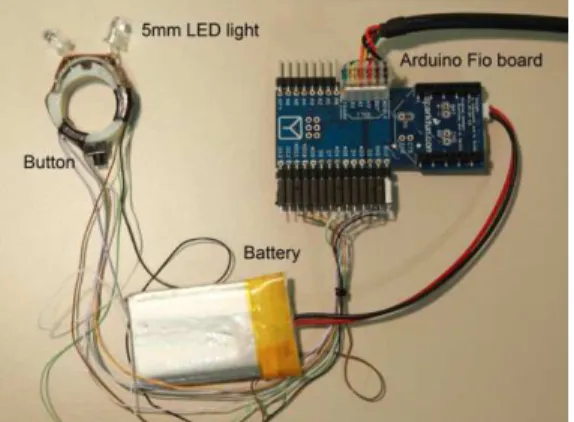HAL Id: hal-00945792
https://hal.archives-ouvertes.fr/hal-00945792
Submitted on 13 Feb 2014
HAL is a multi-disciplinary open access
archive for the deposit and dissemination of
sci-entific research documents, whether they are
pub-lished or not. The documents may come from
teaching and research institutions in France or
abroad, or from public or private research centers.
L’archive ouverte pluridisciplinaire HAL, est
destinée au dépôt et à la diffusion de documents
scientifiques de niveau recherche, publiés ou non,
émanant des établissements d’enseignement et de
recherche français ou étrangers, des laboratoires
publics ou privés.
Getting Users’ Attention using LEDs
Lin Sun, Simon Perrault, Eric Lecolinet
To cite this version:
Getting Users
’ Attention using LEDs
Lin Sun
Simon T. Perrault
Eric Lecolinet
Telecom ParisTech - CNRS LTCI UMR 5141
46 rue Barrault, Paris, France
{firstname}.{lastname}@mines-telecom.fr
ABSTRACTIn this paper, we briefly present a ring prototype that could draw users’ attention in order to transmit notifications in a non intrusive way to its wearer.
Author Keywords
Light; notifications; LED; wearable computing; ring; digital jewelry; information; attention; mobile computing.
ACM Classification Keywords
H.5.2. [Information interfaces and presentation]: User Interfaces - Prototyping.
THE RING RING
We wanted to design a wearable device that users would easily see while doing everyday life tasks. According to [3], the best location on the body was on the wrist. Because we also aimed for simplicity and convenience, we decided that our wearable device should be a ring. We printed an adapted ring pattern on a 3D printer, on which we added two 5mm RGB LEDs on top and a small button on the bottom.
Figure 1. The Ring ring prototype.
Our prototype was then connected to an Arduino Fio board with a Bluetooth shield for communication and an external battery for power. For the purpose of the experiment, only
one LED was used, the other being present as a back-up. Each 5mm LED can emit up to 8 cd in a 30° angle, corresponding to a luminous flux of 1.72 lm.
By focusing on the most important features, we managed to design a simple ring that could be easily produced as a real commercial product. We envision such a ring as a perfect companion and enhancement for a smartphone.
APPLICATIONS
We designed the Ring ring so that it could be simple yet useful in many scenarios. Drawing attention for important notifications was the main feature we envisioned, but there are many other: it could help users find their phone when they forget its location (in a crowded room), also as shown by previous works [1, 2, 4], a single LED can be used to carry very rich information. Finally, a ring could be paired to exchange information or even for lovers, since ring usually carry a strong emotional value.
FUTURE WORK
We would like to evaluate this prototype in real life situations. The factors of the experiment would be the task (and posture), along with the brightness of environnement. This study could help us determine under which conditions the user can quickly catch notifications from the ring.
REFERENCES
1. Campbell, C. S. and Tarasewich, P. Designing visual notification cues for mobile devices. In CHI EA 2004. ACM, 1199-1202.
2. Harrison, C., Horstman, J., Hsieh, G. and Hudson, S. Unlocking the expressivity of point lights. In Proc. CHI
2012. ACM, 1683-1692.
3. Harrison, C., Lim, B. Y., Shick, A. and Hudson, S. E. Where to locate wearable displays?: reaction time performance of visual alerts from tip to toe. In Proc.
CHI 2009. ACM, 941-944.
4. Tarasewich, P., Campbell, C., Xia, T., and Dideles, M. Evaluation of Visual Notification Cues for Ubiquitous Computing. In Proc. UbiComp 2003, Springer, 349-366.
